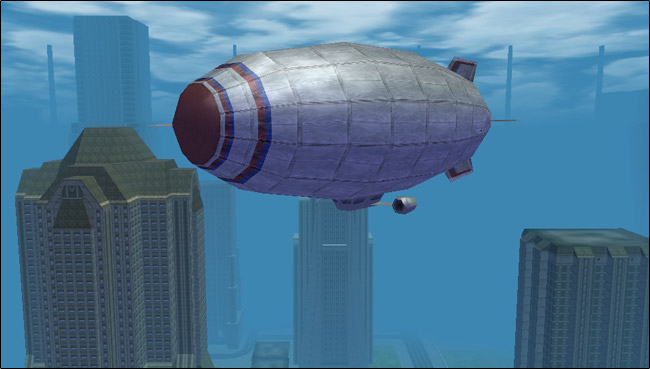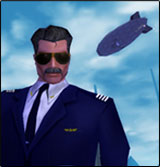Paragon Times/20050330
Flying high in the Spirit of Freedom
By Jackson Turner
Senior Times Staff
PARAGON CITY — On any given day or night in Paragon City, if you look skywards, you’ll see, as Statesman once remarked, “A graceful, soaring symbol of freedom and liberty, ever vigilant, ever ready.” And commanding this symbol is Captain James Finney. It would be no exaggeration to say that Captain Finney knows the city from 3,000 feet better than anyone—and he’s no super-powered hero with the gift of flight. “I do it the old fashioned way,” he says with a wry smile, “with a lot of gas.”
Since 1990, Captain Finney, 49, a former Air Force and commercial pilot, has been flying the skies over Paragon City aboard the airship Spirit of Freedom. “People call it a Zeppelin or dirigible. Technically, it’s a non-rigid, lighter-than-air (LTA) craft, or more commonly, a blimp.”Captain Finney, who is the very image of a pilot—tall and commanding in his blue captain’s uniform, with a full head of salt and pepper hair, and steely blue
eyes—is Chief Pilot of the Narragansett Airship Company’s (NAC) newest Spirit of Freedom—the previous Spirit of Freedom having been destroyed during the Rikti Invasion of 2002. This new airship, built in 2003 by the famed American Blimp Corporation in Oregon, is a twin turbo-prop, modified A-60+ airship. 128 feet from nose to stern, she holds 69,000 cubic feet of helium. “It takes a crew of at least 14 to maintain and support a single blimp,” says Captain Finney. The Spirit of Freedom makes her home at the old Warwick naval air station, now called NAC Field, where she’s one of four blimps and the company’s flagship.
“The actual name, Spirit of Freedom, goes back to the first dirigible airship that NAC commissioned in 1935,” says Captain Finney. “The early 1930s were probably the apex of airship interest and usage around the world. Commercial passenger flights were the next big thing. That all came crashing to the ground on May 6, 1937 at Lakehurst, New Jersey.”
On that day, when Germany’s majestic dirigible Hindenburg erupted in flames while landing at Lakehurst, the dreams of giant airships ferrying passengers across the oceans burned with it. “Interest waned and turned towards fixed-wing aircraft,” says Captain Finney.
Airships didn’t completely disappear from aviation, however. With the advent of World War II, the U.S. Navy saw the benefits of using blimps for coastal reconnaissance, surveillance and escort duties. The post-war years saw great improvements in airship design




